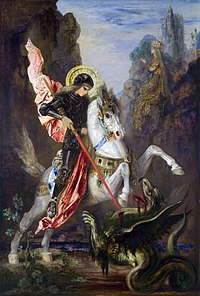Today's the annual celebration of the most famous dragon-slayer in history, if you believe the myths!

|
So, who might be celebrating him? According to Wikipedia, he's the patron saint of Aragon, Catalonia, England, Ethiopia, Georgia, Greece, Lithuania, Palestine, Portugal, and Russia.
If you're resident of one of these cities, you'll also be celebrating him, as he's your patron saint: Amersfoort, Beirut, Fakiha, Bteghrine, Cá¡ceres (Spain), Ferrara, Freiburg, Genoa, Ljubljana, Gozo, Milan, Pomorie, Preston, Salford, Qormi, Rio de Janeiro, Lod, Barcelona and Moscow. Don't live in any of those places? Well, are you an agricultural worker, archer, armourer, butcher, cavalryperson, farmer, field worker, involved in a horsey occupation, knight, sheep, shepherd or soldier? No? Are you afflicted with herpes, lepers, plague, a skin disease or syphillis? (Yikes!) |
Apparently his dad was a Roman Army officer from Cappadocia and his mum from Palestine, and unsurprisingly decided to follow his dad's career. Incidentally, George apparently translates as "worker of the land", so that's probably where the various agricultural patronages originate. Allegedly in the year AD 302, the emperor Diocletian decided that every Christian soldier be arrested and all the others offer sacrifices to the pagan gods. The story goes that George objected and petitioned the emperor, who attempted to bribe him to convert with offers of money, land and slaves. George refused, so was tortured and beheaded.
As for the legend (brought back from the crusades), a dragon decided to make its nest at the spring that provided water for a city. In order to collect water, the residents had to persuade the dragon to move elsewhere for a few minutes. So each day they would offer a sheep, but if no sheep could be found, they'd draw lots and send a maiden to be the dragon's next meal. By sheer coincidence, on the same day the city's princess drew the short straw, George turned up, protected himself with the sign of the cross, slayed the dragon, and rescued the damsel in distress. Of course, all the residents were so in awe of this they immediately abandoned their pagan ways and converted to Christianity. The legend doesn't say what happened next, but presumably George then continued on his crusading ways, without winning over the girl's heart (unlike modern heroic stories).
Oh, and if you're not into dragon-slaying Roman soldiers, 23rd April also marks the death of a 17th century glovemaker's son from Stratford-upon-Avon, who may have written the occasional play or two...
[EDIT Removed a stray 'a']


Comments
England's Cross of St. George
St. George is also the patron Saint of England. His red cross upon a white field was the flag of England from 1215 until 1606. After the last of the Tudor monarchs died in 1603 and James the Sixth of Scotland became James the First of England, the First Union Flag was created by adding the white cross upon a blue field representing St. Andrew of Scotland to St. George’s cross.
"You may be what you resolve to be."
T.J. Jackson
Well, if you read Dickson...
The Dragons and the Georges (their word for humans) CAN get along okay... Sorta...